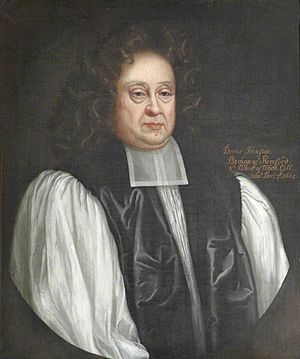Gilbert Ironside the younger facts for kids
Quick facts for kids The Right Reverend Gilbert Ironside |
|
|---|---|
| Bishop of Hereford | |
 |
|
| Church | Church of England |
| Diocese | Diocese of Hereford |
| In Office | 1691–1701 |
| Predecessor | Herbert Croft |
| Successor | Humphrey Humphreys |
| Other posts | Bishop of Bristol (1689–1691) |
| Personal details | |
| Born | 1632 Winterbourne Abbas |
| Died | 27 August 1721 London |
| Nationality | British |
| Denomination | Anglican |
| Alma mater | Wadham College, Oxford |
Gilbert Ironside the younger (born 1632, died 27 August 1701) was an important English church leader and scholar. He served as the head, or Warden, of Wadham College, Oxford, starting in 1667. Later, he became a Bishop of Bristol and then a Bishop of Hereford.
Contents
Gilbert Ironside's Early Life and Education
Gilbert Ironside was the third son of Gilbert Ironside the elder. He was born in a place called Winterbourne Abbas. On November 14, 1650, he started his studies at Wadham College, Oxford. This is known as matriculating.
He earned several degrees during his time there:
- He received his BA degree on February 4, 1653.
- He earned his MA degree on June 22, 1655.
- He became a BD on October 12, 1664.
- Finally, he earned his DD degree on June 30, 1666.
Gilbert Ironside became a scholar at his college in 1651 and a fellow in 1656. A fellow is like a senior member of the college. He also held various important roles:
- He was a public reader in grammar in 1659.
- He worked as a bursar, managing the college's money, in 1659 and 1661.
- He was a sub-warden in 1660, helping the main warden.
- He served as the college librarian in 1662.
In 1663, he became the rector (a type of priest) of Winterbourne Faringdon. Then, in 1666, he also took over as rector of Winterbourne Steepleton, following in his father's footsteps.
Leading Wadham College and Oxford University
In 1665, the previous Warden of Wadham College, Walter Blandford, moved to a new role. Gilbert Ironside was then chosen to be the new Warden of Wadham College on December 7, 1665. He held this important position for 25 years, until he resigned in 1689.
Gilbert Ironside was known for standing up for what he believed in. He disagreed with John Fell, another powerful figure at Oxford. Ironside even refused to serve as Vice-Chancellor (a very senior role in the university) while Fell was alive. After Fell passed away in 1686, Ironside took on the Vice-Chancellor role from 1687 to 1689.
Standing Up to King James II
In September 1687, King James II visited Oxford. He wanted to force Magdalen College to accept his chosen person, Anthony Farmer, as their new President. Gilbert Ironside bravely spoke with the King. He insisted that the fellows (senior members) of Magdalen College had the right to choose their own leader.
Later, in November, the King's special commissioners removed the fellows of Magdalen College. Ironside refused an invitation to dine with these commissioners that evening. This showed his strong support for the college's rights.
Becoming a Bishop
After the Glorious Revolution in 1688, which changed who was on the throne, Gilbert Ironside was rewarded for his courage. He was appointed Bishop of Bristol on October 13, 1689. The Bristol diocese (area of a bishop's authority) was not very wealthy. So, it was agreed that he would move to a richer diocese when a chance came up.
That chance came in July 1691, after Bishop Herbert Croft died. Gilbert Ironside was then transferred to become the Bishop of Hereford. He passed away on August 27, 1701, and was buried in a church in London. Later, when that church was taken down in 1867, his remains were moved to Hereford Cathedral.
What Gilbert Ironside Wrote
Gilbert Ironside published a few works during his life. He wrote a short introduction for Nicholas Ridley's account of a discussion about the sacrament, along with a letter from John Bradford. This was published in Oxford in 1688. He also published a sermon (a religious speech) that he gave before the king on November 23, 1684. This sermon was published in Oxford in 1685.
A painting of Gilbert Ironside can be seen in the main hall of Wadham College.
Sources
 This article incorporates text from a publication now in the public domain: "Ironside, Gilbert (1632-1701)". Dictionary of National Biography. (1885–1900). London: Smith, Elder & Co.
This article incorporates text from a publication now in the public domain: "Ironside, Gilbert (1632-1701)". Dictionary of National Biography. (1885–1900). London: Smith, Elder & Co.
| Academic offices | ||
|---|---|---|
| Preceded by Walter Blandford |
Warden of Wadham College, Oxford 1665–1689 |
Succeeded by Thomas Dunster |
| Preceded by John Venn |
Vice-Chancellor of Oxford University 1687–1689 |
Succeeded by Jonathan Edwards |
| Church of England titles | ||
| Preceded by Sir Jonathan Trelawny, 3rd Baronet |
Bishop of Bristol 1689–1691 |
Succeeded by John Hall |
| Preceded by Herbert Croft |
Bishop of Hereford 1691–1701 |
Succeeded by Humphrey Humphreys |

